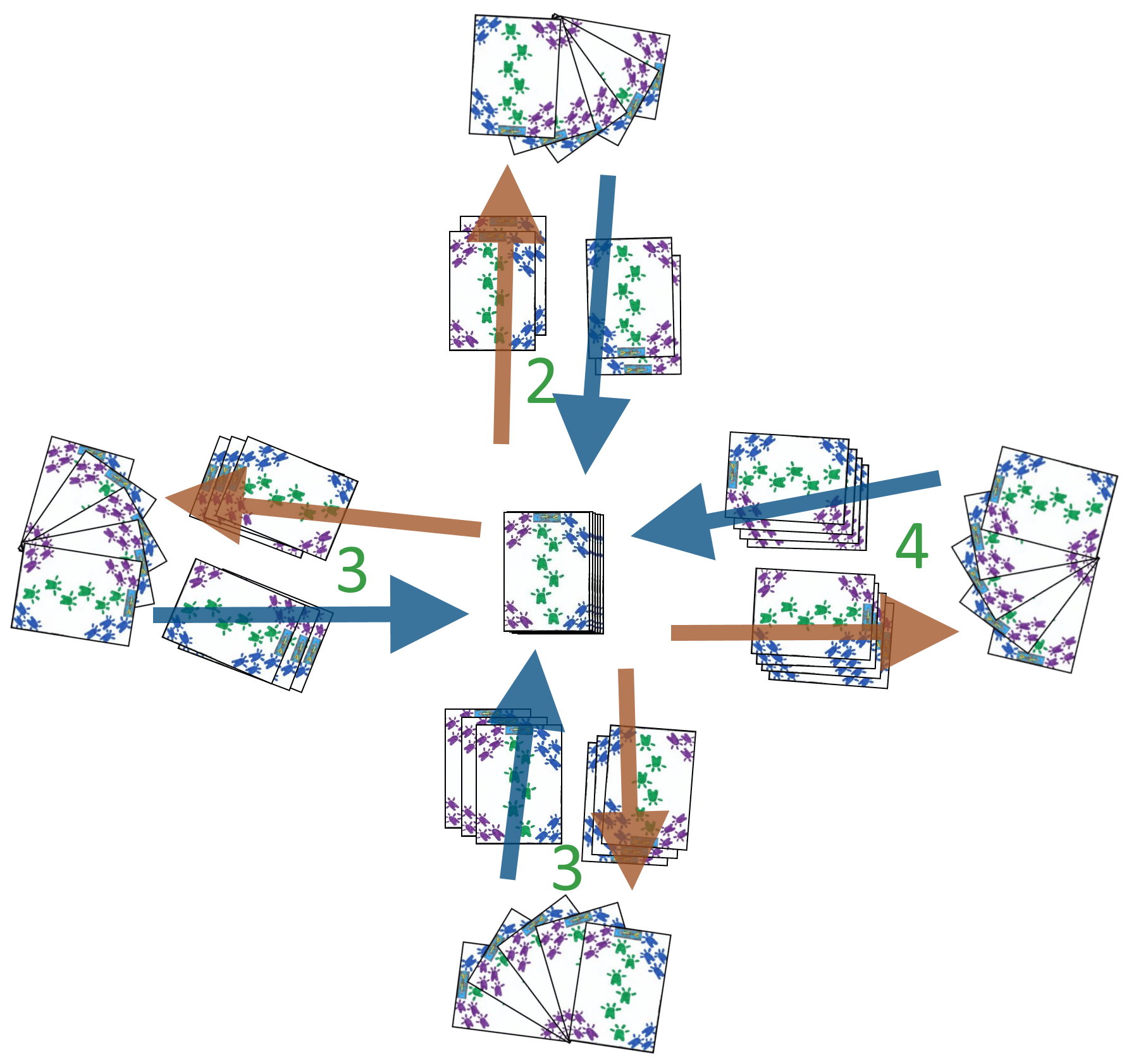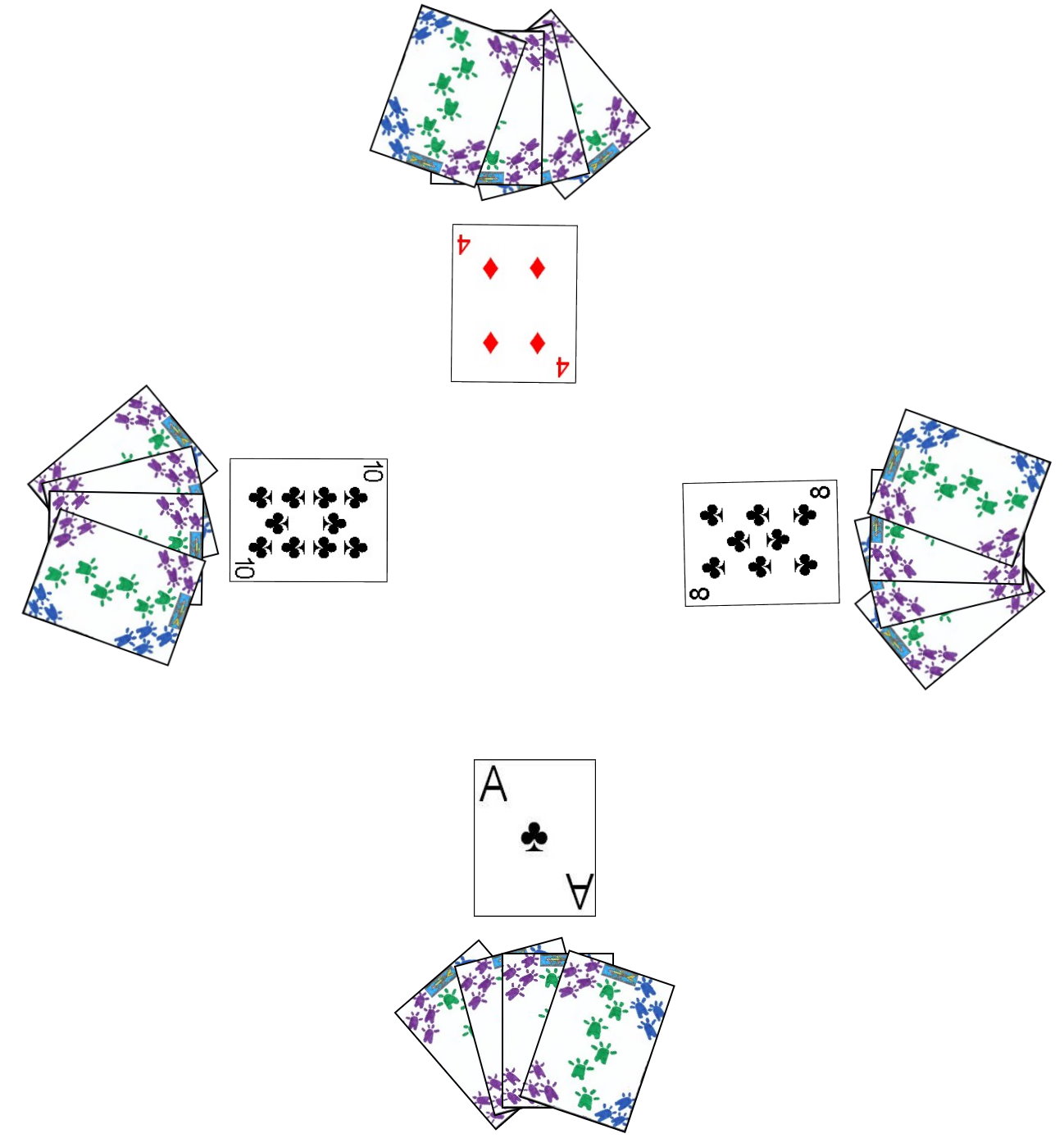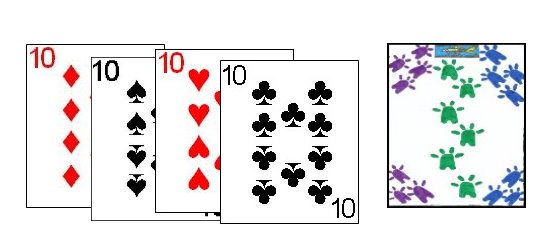Despite sharing the same name as a major city found in the United States, Chicago is actually a card game played throughout Sweden, particularly in the areas near Stockholm. This game should not be confused with the Contract Bridge variant also called Chicago. The instructions for playing that game can be found at this link.
Chicago is part vying game in which players compare cards in various combinations, and part trick taking game, in which each hand is played over the series of several phases. The game uses one standard 52 card deck and is usually played by 2 to 4 players. The ranking of the cards in this deck are as follows (from high to low): Ace, King, Queen, Jack, 10, 9, 8, 7, 6, 5, 4, 3, 2.
 Determination of the first dealer and seating positions can be done in using any method, with draw for high cards a common method. In that method, each player would draw a card from the shuffled, face-down deck. Any players drawing cards of the same rank should discard those cards and draw again, until drawing a card of a rank no player has previously drawn. The players would then seat themselves at the table in the order of cards drawn from highest to lowest. The player drawing the highest ranked card of all would be set as the first dealer.
Determination of the first dealer and seating positions can be done in using any method, with draw for high cards a common method. In that method, each player would draw a card from the shuffled, face-down deck. Any players drawing cards of the same rank should discard those cards and draw again, until drawing a card of a rank no player has previously drawn. The players would then seat themselves at the table in the order of cards drawn from highest to lowest. The player drawing the highest ranked card of all would be set as the first dealer.
The dealer would then thoroughly shuffle the deck and pass it to the player at his immediate right to cut. After the cut, the dealer then begins distributing the cards to the players, one-by-one and face-down in a clockwise direction starting with the player at his right. He continues dealing until each player has exactly five cards. The dealer then places the remainder of the deck face-down in the center of the table.
As mentioned, the game is played in a series of phases. On the first phase, each player examines his hand and may opt to exchange any number of cards (from 0 to 5) from his hand for replacements from the undealt remainder of the face-down deck. This option starts with the player to the immediate left of the dealer and proceeds around the table until each player has had one opportunity to exchange cards. Before receiving any replacement cards the player must first discard with the cards discarded by each player added to a face-down discard pile. In discarding the player should also announce the number of cards discarded such that the dealer will know the number of cards needed to replenish that player's hand to five cards. The object during this phase is for the players to create the highest point scoring combination in hand.
After each player has had one opportunity to discard cards, the players then have the opportunity to declare one of the point scoring combinations or Pass. This declaration starts with the player to the dealer's immediate left and rotates around the table such that each player has had one opportunity to declare a combination. If a player does not have any point scoring combination, or his combination is not higher (or in some cases equal) than one already announced he must pass. The following are the ranking of the combinations players can declare (listed in ascending order from lowest to highest). It should be noted that during this phase, players do not actually have to show the hand, however, in later portions of the hand they will be required to, so if a player states a combination they do not actually have it will soon become readily apparent and a player who is found to falsely represents his hand in this way immediately loses the game.
| Combination Name | Description of Combination | Point Value | Example |
|---|---|---|---|
| One Pair | Five cards with two cards in the hand of the exact same rank. In comparing two or more such One Pair combinations, the higher ranking paired cards is considered the higher. If the pair is equal, the highest card of the remaining three is compared to determine which combination is considered the higher. | 1 |  |
| Two Pairs | Five cards, with two cards in the hand of the exact same rank and two other cards in the hand of matching rank. In comparing two or more such "Two Pairs" combinations, the higher ranking pair in each hand is compared and the higher of these is considered the higher. If these pairs are of the same rank, the second pair is compared and the highest of these considered the higher. If the second pair is also equal, the highest third card is compared. | 2 |  |
| Trips | Five cards, with three cards in the hand all of the exact same rank. In comparing two or more such combinations, the three matching cards of the highest ranking are considered the highest. | 3 |  |
| Straight | Five cards, all in direct sequential order, of mixed suits. In comparing two or more such combinations of this type, the Straight which ends with the highest card is considered the highest. | 4 |  |
| Flush | Five cards in the hand, all of the same suit but not necessarily in direct sequential order. In comparing two or more such combinations of this type, the highest is considered the hand containing the highest ranked card. | 5 |  |
| Full House | Five cards, with three of the cards being all of the same rank, and the remaining cards in the hand being of matched rank. In comparing multiple such combinations of this type, the higher is that which contains the higher three of a kind. | 6 |  |
| Four of a Kind | Five cards, with four of the cards all of the exact same rank. In comparing multiple hands with this announced combination, the highest is that containing the higher cards comprising the four of a kind. | 7 |  |
| Straight Flush | Five cards all of the same suit and in direct sequential order. In comparing two or more of this type of combination, the hands are compared based on the highest card in that hand, with that combination containing that higher card considered the highest. | 8 |
 |
| Royal Flush | One card each in ranks 10, Jack, Queen, King and Ace, all of the same suit. | Instant Win |  |
If two or more players announce the same combination type, and that combination ends up being the highest so announced during this phase, the players who have those combinations must then share enough information about their hand to determine which is higher. Once it is determined which combination is the highest, the player with the highest scoring combination, scores the number of points as per the Point Value identified in the chart above. If every player passes (indicating no player had a combination of at least one pair or better), no player scores in this first phase.
After the scores for the first phase are recorded, the second phase begins. In this phase, each player again, in proper turn starting with the player at the dealer's left, has the opportunity to exchange 0 to 5 cards from his hand, in an attempt to improve his hand. If the player who scored in the first phase exchanges any cards from his hand, that player must first show his cards to prove he had the combination previously announced.
After this card exchange, each player again, starting with the player at the immediate left of the dealer announces his combination in hand or passes. The ranking of these combinations as well as the scoring value is exactly the same as in the first phase of the game.
If, during any draw phase, the deck does not have enough cards to replenish the hands of those player wanting to draw new cards, all previously discarded cards during the hand are shuffled together to make a new deck for which these draws can be completed from.
After the scores for the second phase are so scored for the highest scoring combination, the third phase of the game begins. Once more, each player, starting with the player at the dealer's immediate left and proceeding in a clockwise rotation, has one opportunity to exchange up to five cards, discarding an equal number of cards before receiving new ones. As in the second round, if a player who previously scored in a prior hand discards any cards from his winning combination, he must first show the combination to the other players before discarding and receiving the replacement cards. The purpose of this discard is slightly different than previous discards, however. In this discard and draw phase, the players are not only attempting to acquire the highest scoring combination in hand, but also the necessary cards to enable that player to win the last trick in a trick taking round.
 Thus after each player has received his requested number of cards, a trick taking round begins. When
playing a card to a trick, the player should play the card immediately in front of himself, in order to keep his hand intact for later comparison of combinations for scoring.
Thus after each player has received his requested number of cards, a trick taking round begins. When
playing a card to a trick, the player should play the card immediately in front of himself, in order to keep his hand intact for later comparison of combinations for scoring.
Thus, to begin the player to the immediate left of the dealer leads the first card to the first trick, and each other player in a clockwise direction plays one card to the trick. If a player has a card of the same suit as led to that trick he must play it. If he has no such card he may play any card from his hand to the trick. The player of the highest card of the suit originally led to the trick wins that trick, and that same player leads the first card to the next trick. The winner of the fifth and final trick earns five points, added to his accumulated score. Each card as played by each player is left in front of that player, regardless of who actually wins each trick, in order for one final comparison at the end of the trick taking phase.
After the trick taking phase, each player would then have his five cards played to tricks face-up in front of himself. These card combinations are compared, and whichever player has the highest scoring combination, as indicated in the chart above, earns the number of points for that combination.
After this last comparison phase, the cards are all gathered and shuffled for the next hand, which should be shuffled and dealt by the next dealer in turn.
The Chicago: A player may, after the third round card exchange, announce "Chicago". He must do this before the first card is led to the first trick. In order to do this, that player must currently have a score of 15 points or more. In order to do this, a player simply announces "Chicago". This is an announcement by that player that he intends to win all five tricks. If the player manages to win all five tricks, he wins 15 total points for doing so. However, if the player does not manage to win every trick during the hand, he loses 15 points instead. If any player does declare "Chicago", no points are scored in that hand for having the best combination in the last phase of this hand.
If a player's score, at the beginning of a hand is 42 points or higher, that player is no longer entitled to trade any cards during each phase, but must continue play with the cards he was originally dealt. If a player's score falls below 42 during the game for a failed call of "Chicago" during a hand, the player may again exchange for cards as normal during each drawing phase.
The game continues over a series of hands until one or more players has reached or exceeded, at the end of a hand, a total of 52 points. At this time, the player with the highest grand total is declared the game winner. Similarly, if any player manages to obtain, in his hand a Royal Flush, he may announce this combination during the normal comparison and that player immediately wins the entire game.
 Zero Out: Another optional rule that is sometimes used is the zero out rule. If this rule is used, a player who manages to create a combination consisting of four of a kind, may elect to either score the normal seven points or may instead opt to have every other player zero out, in other words all other player's scores are reset back to a score of zero. If a player opts to use the zero out rule, after the other scores are reset to zero, the hand instantly ends and the next hand is dealt as normal by the next dealer in turn.
Zero Out: Another optional rule that is sometimes used is the zero out rule. If this rule is used, a player who manages to create a combination consisting of four of a kind, may elect to either score the normal seven points or may instead opt to have every other player zero out, in other words all other player's scores are reset back to a score of zero. If a player opts to use the zero out rule, after the other scores are reset to zero, the hand instantly ends and the next hand is dealt as normal by the next dealer in turn.